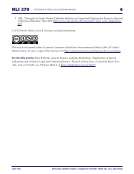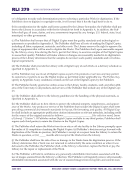RLI 279 18
June 2012 Research Library Issues: A QuarterlLy Report from ARL, CNI, and SPARC
Copyright Risk Management
seems more complex than negligence or employment discrimination law. In those areas there are well-
established practices that library administrators can follow in order to avoid some of the potential
risks, whereas copyright law seems like a morass out of which it appears too difficult to select the right
questions to ask and principles on which to rely for complex digitization projects. The purpose of this
paper is to outline two fundamental principles of copyright risk management for mass digitization and
four strategies to implement those principles.
Let me emphasize that nothing presented here is legally innovative or startling in any way. The
principles and strategies proposed are entirely straightforward and commonsensical. The goal of this
article is to prompt library practitioners to reconsider how they regularly think about copyright law and
large-scale digitization, not to make any creative legal arguments.
Principles in Copyright Decision Making
Librarians tend to focus on a single copyright principle when considering a specific potential digitization
project. The reasoning often seems to be that digitization can only proceed if all of the subject materials
are in the public domain, or only if a convincing fair-use argument can
be made that applies to all of the material. There is no basis in the law
for this assumption, and a risk-management approach can help clarify
the way in which the different exceptions and limitations in copyright
law can work together to reduce the risk of conflict or liability.
For large-scale digitization projects that involve heterogeneous
materials from the period when copyright protection may persist,
there are two simple principles that a library administrator seeking
to manage risk should apply. First, try to reduce the number of risky
items that a collection contains. Second, try to reduce the number of people who are likely to want to sue
you over the collection. This may seem almost laughably obvious, but thinking about a project in terms
of potential points of contention and potential litigants happens fairly infrequently and can be very
productive in terms of risk management.
One obstacle to this kind of reasoning is sometimes that librarians simply do not want to think
in terms of potential lawsuits. Even abstract reasoning about the potential of getting sued can make
one nervous, and if librarians are talking with their university counsel it also may provoke an adverse
reaction. But in reality we are thinking about potential lawsuits when we post discrimination and
harassment procedures as well, although we are also considering the health of our working environment.
All legal considerations in libraries involve some attention to avoiding legal conflicts, and there is no
sound reason that copyright should be treated differently. Indeed, considering large-scale digitization in
this way has a significant benefit. Once the questions about potential points of contention and potential
plaintiffs are considered, the relatively low risk involved in many projects will become apparent, as will
the strategies that can be pursued to further reduce that risk. What initially may seem a frightening
subject to consider—who might sue us over what material—actually proves to be quite empowering when
applied to many collections that might be considered for large-scale digitization.
First, try to reduce the number
of risky items that a collection
contains. Second, try to reduce
the number of people who are
likely to want to sue you over
the collection.
June 2012 Research Library Issues: A QuarterlLy Report from ARL, CNI, and SPARC
Copyright Risk Management
seems more complex than negligence or employment discrimination law. In those areas there are well-
established practices that library administrators can follow in order to avoid some of the potential
risks, whereas copyright law seems like a morass out of which it appears too difficult to select the right
questions to ask and principles on which to rely for complex digitization projects. The purpose of this
paper is to outline two fundamental principles of copyright risk management for mass digitization and
four strategies to implement those principles.
Let me emphasize that nothing presented here is legally innovative or startling in any way. The
principles and strategies proposed are entirely straightforward and commonsensical. The goal of this
article is to prompt library practitioners to reconsider how they regularly think about copyright law and
large-scale digitization, not to make any creative legal arguments.
Principles in Copyright Decision Making
Librarians tend to focus on a single copyright principle when considering a specific potential digitization
project. The reasoning often seems to be that digitization can only proceed if all of the subject materials
are in the public domain, or only if a convincing fair-use argument can
be made that applies to all of the material. There is no basis in the law
for this assumption, and a risk-management approach can help clarify
the way in which the different exceptions and limitations in copyright
law can work together to reduce the risk of conflict or liability.
For large-scale digitization projects that involve heterogeneous
materials from the period when copyright protection may persist,
there are two simple principles that a library administrator seeking
to manage risk should apply. First, try to reduce the number of risky
items that a collection contains. Second, try to reduce the number of people who are likely to want to sue
you over the collection. This may seem almost laughably obvious, but thinking about a project in terms
of potential points of contention and potential litigants happens fairly infrequently and can be very
productive in terms of risk management.
One obstacle to this kind of reasoning is sometimes that librarians simply do not want to think
in terms of potential lawsuits. Even abstract reasoning about the potential of getting sued can make
one nervous, and if librarians are talking with their university counsel it also may provoke an adverse
reaction. But in reality we are thinking about potential lawsuits when we post discrimination and
harassment procedures as well, although we are also considering the health of our working environment.
All legal considerations in libraries involve some attention to avoiding legal conflicts, and there is no
sound reason that copyright should be treated differently. Indeed, considering large-scale digitization in
this way has a significant benefit. Once the questions about potential points of contention and potential
plaintiffs are considered, the relatively low risk involved in many projects will become apparent, as will
the strategies that can be pursued to further reduce that risk. What initially may seem a frightening
subject to consider—who might sue us over what material—actually proves to be quite empowering when
applied to many collections that might be considered for large-scale digitization.
First, try to reduce the number
of risky items that a collection
contains. Second, try to reduce
the number of people who are
likely to want to sue you over
the collection.
























